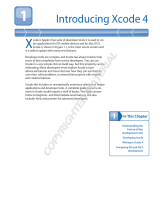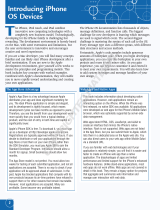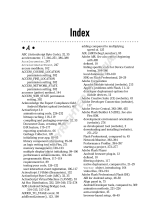Page is loading ...

ADOBE® ILLUSTRATOR® CC 2014
ADOBE ILLUSTRATOR CC
2014
PORTING GUIDE

2014 Adobe Systems Incorporated. All rights reserved.
Adobe Illustrator CC 2014 Porting Guide
Technical Note #10500
If this guide is distributed with software that includes an end user agreement, this guide, as well as the software
described in it, is furnished under license and may be used or copied only in accordance with the terms of such license.
Except as permitted by any such license, no part of this guide may be reproduced, stored in a retrieval system, or
transmitted, in any form or by any means, electronic, mechanical, recording, or otherwise, without the prior written
permission of Adobe Systems Incorporated. Please note that the content in this guide is protected under copyright law
even if it is not distributed with software that includes an end user license agreement.
The content of this guide is furnished for informational use only, is subject to change without notice, and should not be
construed as a commitment by Adobe Systems Incorporated. Adobe Systems Incorporated assumes no responsibility or
liability for any errors or inaccuracies that may appear in the informational content contained in this guide.
Please remember that existing artwork or images that you may want to include in your project may be protected under
copyright law. The unauthorized incorporation of such material into your new work could be a violation of the rights of
the copyright owner. Please be sure to obtain any permission required from the copyright owner.
Any references to company names in sample templates are for demonstration purposes only and are not intended to
refer to any actual organization.
Adobe, the Adobe logo, Creative Cloud, Illustrator, and Flash are either registered trademarks or trademarks of Adobe
Systems Incorporated in the United States and/or other countries. Microsoft and Windows are either registered
trademarks or trademarks of Microsoft Corporation in the United States and/or other countries. Apple, Mac OS, and
Macintosh are trademarks of Apple Computer, Incorporated, registered in the United States and other countries. All
other trademarks are the property of their respective owners.
Adobe Systems Incorporated, 345 Park Avenue, San Jose, California 95110, USA. Notice to U.S. Government End Users.
The Software and Documentation are “Commercial Items,” as that term is defined at 48 C.F.R. §2.101, consisting of
“Commercial Computer Software” and “Commercial Computer Software Documentation,” as such terms are used in 48
C.F.R. §12.212 or 48 C.F.R. §227.7202, as applicable. Consistent with 48 C.F.R. §12.212 or 48 C.F.R. §§227.7202-1 through
227.7202-4, as applicable, the Commercial Computer Software and Commercial Computer Software Documentation are
being licensed to U.S. Government end users (a) only as Commercial Items and (b) with only those rights as are granted
to all other end users pursuant to the terms and conditions herein. Unpublished-rights reserved under the copyright
laws of the United States. Adobe Systems Incorporated, 345 Park Avenue, San Jose, CA 95110-2704, USA. For U.S.
Government End Users, Adobe agrees to comply with all applicable equal opportunity laws including, if appropriate, the
provisions of Executive Order 11246, as amended, Section 402 of the Vietnam Era Veterans Readjustment Assistance Act
of 1974 (38 USC 4212), and Section 503 of the Rehabilitation Act of 1973, as amended, and the regulations at 41 CFR
Parts 60-1 through 60-60, 60-250, and 60-741. The affirmative action clause and regulations contained in the preceding
sentence shall be incorporated by reference.

3
Adobe Illustrator CC 2014 Porting Guide
This document describes how to update your SDK plug-in code and development environments for
Adobe® Illustrator® CC 2014. It details changes in the public API and other aspects of the SDK since the
previous release.
Introduction
Download the Illustrator CC 2014 SDK from http://www.adobe.com/devnet/illustrator/, along with
installation instructions and documentation.
The Creative Cloud™ 2014 version requires a different development environment from previous releases;
this means that you must recompile plug-ins built with an earlier version of the Illustrator SDK in order for
them to run in Illustrator CC 2014. See “
Development environment” on page 4.
SDK organization
The SDK contains these folders and files (locations are relative to the download location, <SDK>):
docs/
Documentation, including:
Adobe Illustrator CC 2014 Programmer’s Guide
(
guides/programmers-guide.pdf)
Porting Guide (this document)
Getting Started with Illustrator CC 2014 Development
(
guides/getting-started-guide.pdf)
Using the Adobe Text Engine (guides/using-adobe-text-engine.pdf)
API Reference
This document is provided in two formats:
references/index.chm — This compiled HTML file allows text searches
to be performed on the content. See the Getting Started with Illustrator CC
2014 Development for details.
references/sdkdocs.tar.gz — This file contains the API Reference in
HTML format. To view the contents, decompress the archive, then open
index.html in your browser.
API Advisor (references/apiadvisor-ai16-vs-ai17.html)
legalnotices/
Licenses.
illustratorapi
The Illustrator API header files.
samplecode/
A set of samples for learning about the API. See “Illustrator SDK changes” on
page 6.

Adobe Illustrator CC 2014 Porting Guide Introduction 4
Changes in this release
These are the major changes between this release and the previous release.
Development environment
The version of Visual Studio has changed. When you open an older solution or project file in the new
version of Visual Studio, you are prompted to update the file.
This release supports these platforms for Illustrator plug-in development.
Resource handling
In Illustrator release 17.1 and later, all resources are kept in raw format. The change was necessary because
the resource-handling API in Mac OS SDK 10.8 and later has been deprecated.
This change requires that you make some changes in how you provide resources, according to the target
platform. You must provide resource mapping files that identify the file type of each resource, and if
needed, map the resource ID to the resource file name.
Resource
handling in
Mac OS
You must add a post-build step to your Xcode project to store resources according to their file types, and
map resource IDs to file names if needed.
1. Select the Target
2. Select the Build Phases tab.
3. Click Add Build Phase (the + icon at the bottom) and choose Add Run Script.
4. In the new script, copy your resource files to sub-folders of
plugin.aip/Contents/Resources/.
(There is an example of such a script in the Annotator sample.)
Platform Component Note
Windows Windows 7 SP1 32-bit or higher
Illustrator CC 2014
Visual Studio 2012 SP4
Visual Studio 2010 replaced the
_SECURE_SCL and _HAS_ITERATOR_DEBUGGING flags with an
_ITERATOR_DEBUG_LEVEL macro. Illustrator defines _ITERATOR_DEBUG_LEVEL=0 for Release, and
_ITERATOR_DEBUG_LEVEL=2 for Debug. We recommend that developers do the same in Visual
Studio 2012.
Mac OS® Mac OS X 10.7 or higher Deployment target should be Mac OS X 10.7
Apple 10.7 SDK
Xcode 4.5.2 Xcode can be downloaded from
http://developer.apple.com/tools/download/
LLVM Clang

Adobe Illustrator CC 2014 Porting Guide Introduction 5
Keep each type of file in a folder named for the file extension. For example, PNG files go into
plugin.aip/Contents/Resources/png/.
5. If your code uses any resource ID that is different from the actual file name, you must create a mapping
file called
IDToFile.txt. This file is itself a text resource, and your post-build script must copy it into
the folder
plugin.aip/Contents/Resources/txt/.
6. For each file that has a resource ID different from the name, add an entry to
IDToFile.txt that maps
the resource ID to the file name. For example, if you have a resource file
AnnotatorTool.png and you
use
16501.png as resource ID in your code, the IDToFile.txt must have this line:
16501.png AnnotatorTool.png
You do not need separate mapping entries for the additional high-definition icons. Resources for the
high-definition icons are loaded automatically based on the standard icon name.
Resource
handling in
Windows
In a Windows Visual C++ plug-in project, the project contains a resource file named plugin_name.rc. You
must add an entry to this file for each resource that identifies the file type.
1. For each resource file, add an entry to the RC file in the format:
resource_name file_type file_name
For example, to use a PNG image resource AnnotatorTool.png:
AnnotatorTool png AnnotatorTool.png
2. If your code uses any resource ID that is different from the actual file name, you must create a mapping
file called
IDToFile.txt. This mapping file is itself a text resource, and requires a line in the RC file:
AnnotatorTool png AnnotatorTool.png
IDToFile txt IDToFile.txt
3. Add a line to the mapping file for each resource ID that maps the ID to the file name. For example:
16501.png AnnotatorTool.png
You do not need separate mapping entries for the additional high-definition icons. Resources for the
high-definition icons are loaded automatically based on the standard icon name.
For examples, see SDK samples that contain resources, such as AnnotatorTool and MultiArrowTool.
HiDPI icon resources
In Illustrator 17.1 and later, any plug-in that creates a tool must supply additional icon resources to support
high-definition (HiDPI) icons for all platforms.
A tool plug-in must provide three resource files for each icon: one for the standard icon definition of each
tool icon, one for the 200% (2x) HiDPI version, and one for the 150% (1.5x) HiDPI version.
The resource files should follow these naming conventions:
ResourceName.png for standard image definitions
ResourceName@2x.png for HiDPI image 2x definitions
ResourceName@3to2x.png for HiDPI image 1.5x definitions
All three resource files for each icon must be added to project as appropriate for the platform:

Adobe Illustrator CC 2014 Porting Guide New features in API 6
In Mac OS, copy the PNG files into the plugin.aip/Contents/Resources/png/ folder in the
post-build step. For example:
AnnotatorTool.png //to specify standard icon
[email protected] //to specify 200% icon
[email protected] //to specify 150% icon
In Windows, add an entry for each PNG file in the plugin_name.rc resource file. The file names for the
HiDPI icons must be enclosed in quotes. For example:
AnnotatorTool png AnnotatorTool.png
AnnotatorTool_at_2x png "[email protected]"
AnnotatorTool_at_3to2x png "[email protected]"
If you have a mapping file for the resource ID (IDToFile.txt), you do not need separate mapping entries
for the additional high-definition icons. Resources for the high-definition icons are loaded automatically
based on the standard icon name.
Examples of the resource files for high-definition icons are provided with the sample tool plug-ins, such as
AnnotatorTool and MultiArrowTool.
New features in API
This section describes new features that have been added to Adobe Illustrator CC 2014 which are
supported in the SDK.
New Live Shape preference keys added in AIPreferenceKeys.h
Enumeration kTransferLiveShapeProperties added to AIArt.h for specifying Live Shape
information.
New functions for GPU Preview mode added in AIDocumentView.h (in Windows only):
AIAPI AIBoolean (*IsGPUPreviewModeOn)(const AIDocumentViewHandle view);
AIAPI AIErr (*GetGPUPixel)(AIWindowRef window, AIPoint location, AIColor& color);
New notifiers:
kAICSXSExtensionUnloadNotifier added to AICSXSExtension.h (for CEP extension unload
event)
EffectiveToolChangedNotifier added to AITool.h
Ilustrator API changes
This section summarizes the important changes to the API since the prior release. A detailed change list is
provided with the SDK, in the API Advisor page,
apiadvisor-report.html.
Illustrator SDK changes
All Flash® -based extensions have been removed from the SDK and replaced with HTML/JavaScript
versions, in order to support the new CC Extension model. See the Adobe Illustrator CC 2014 Programmer’s
Guide.
/



